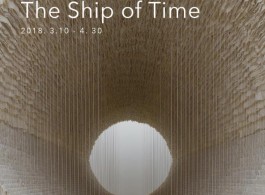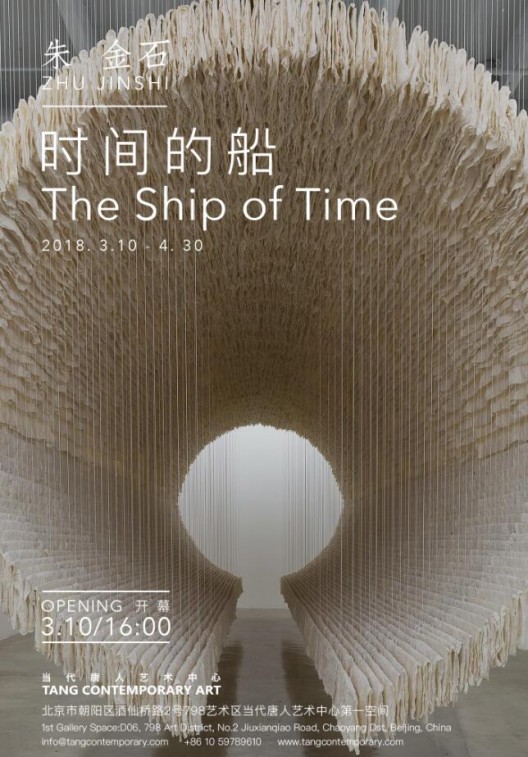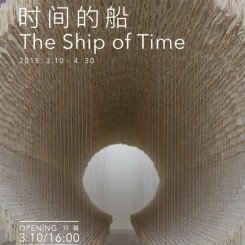‘The Ship of Time’
Tang Contemporary Art, Beijing
Tang Contemporary Art is proud to announce the opening of Zhu Jinshi’s dual solo shows “Ship of Time” and “Rejecting River Currents” on March 10, 2018. Based on the unique architecture of both of Tang Contemporary’s Beijing spaces, these parallel exhibitions will present important works of installation and the artist’s unique “thick paintings.”
In space I The Ship of Time rice paper installation uses exactly 14,000 sheets of rice paper, 1,800 pieces of fine bamboo, and 2,000 cotton threads seven meters long. This summer, the team returned to the ancient villages on Yellow Mountain to develop fireproof rice paper and choose bamboo. Later in the Songzhuang studio, several months were spent shaping the rice paper, baking the bamboo straight, making holes, and cutting three-meter sections. The works were designed specifically for the space, and the two massive beams on the ceiling bear the weight of the suspended installation.
Zhu Jinshi began making rice paper installations in 1988. At the time, he was in Berlin, and he placed a cubic meter of rice paper in Beijing far from him. At the Vancouver Art Gallery in 1997, he shaped 50,000 sheets of rice paper into an installation work eighteen meters high and three meters around. It stood four floors high,suspended in the center of the lobby. Twenty years later, when Zhu Jinshi envisioned a rice paper work in Beijing’s 798, he wanted to reinterpret the Tang Contemporary space. The thin, soft rice paper and bamboo give this massive installation a lightness, contrasting with the weight of Bauhaus industrial architecture and the memory of those times.
Ship of Time has a grand air. When the light shines through the skylight, passing through the dense web of threads to the folds in the rice paper, it is both strong and fragile, firm and soft, projected through our eyes and into our brains. When viewers enter the tunnel of the work, the momentarily closed form opens to the light and dust floating inside it. The memory of rice paper as an ancient material is re-awakened, it produces a spatial illusion that never existed; time resides here in poetry.
In space II,“Rejecting River Currents” showcases Zhu Jinshi’s abstract painting from the early 1980s to the present, with a particular emphasis on his unique “thick paintings” from the last decade. Since completing his first abstract painting in 1980, Zhu Jinshi’s style has changed. He has shifted among styles, gaining experience, but his “thick paintings” have always been distinct. The power of his work impacts viewers, helping them to experience the cutting edge of contemporary painting. Compared to his concise installations, Zhu Jinshi pursued the opposite path in his painting; his paintings are rich and dazzling, chaotic and fierce, wild and aggressive. His painting tools are particular, but very different from those of other artists; his studio contains over one hundred 15-centimeter-wide paintbrushes and plaster trowels coated in thick paint, and several hundred painting palettes that he uses instead of brushes.
Zhu Jinshi’s “thick paintings” ran contrary to the constructivist and neo-geometric mainstream of abstract painting in the 1990s in the West,favoring artist’s own experiences over the monolithic idea of traditional abstraction.Zhu ’ s paintings defy the neat boundaries that have been set between media(painting/sculpture/installation) and the difference between a local and transnational understanding of abstract art. His paintings are more about the material itself than about any particular subject. This does not necessarily reflect only a preoccupation with formal concerns. As with all of Zhu’s works, he has an interest in making meaning from material.
The two parallel threads of abstract painting and conceptual installation have been woven into Zhu’s artistic practice over the last forty years. The juxtaposition of these two shows gives viewers the chance to experience the aesthetic of contemporary art today.



